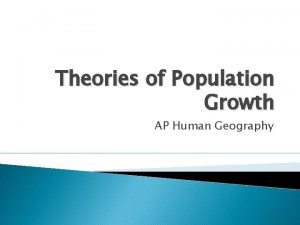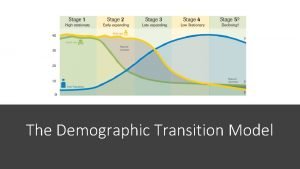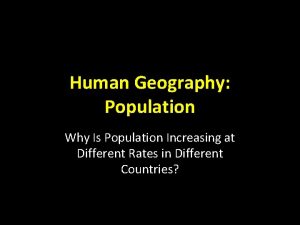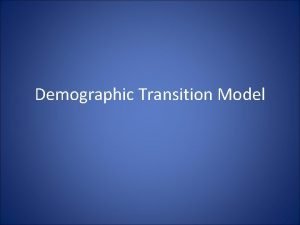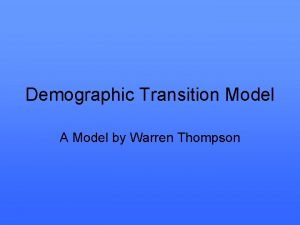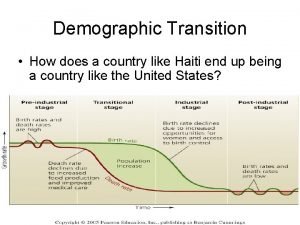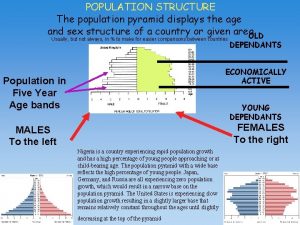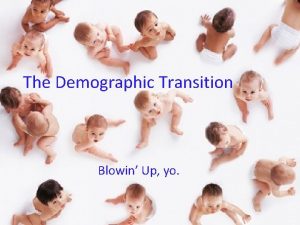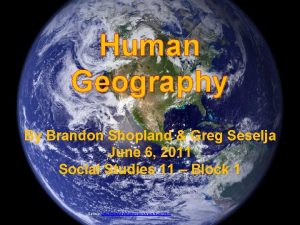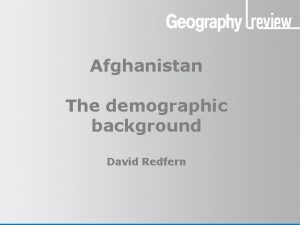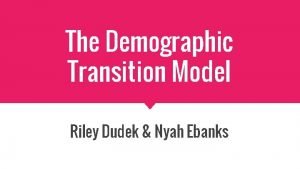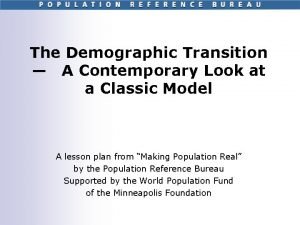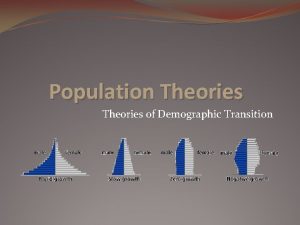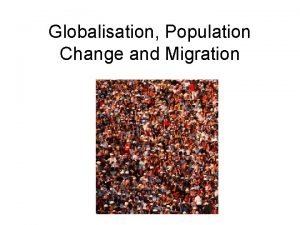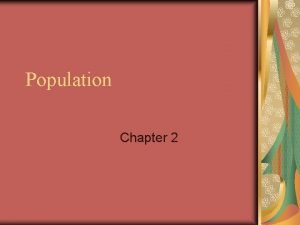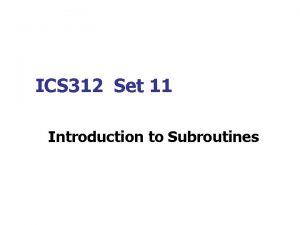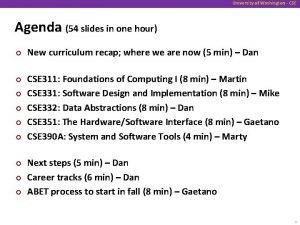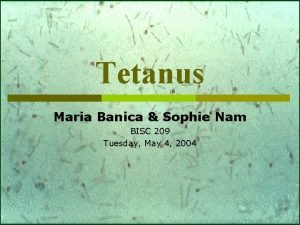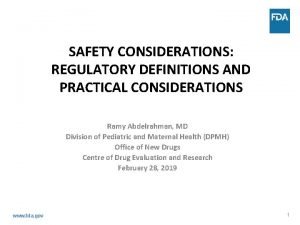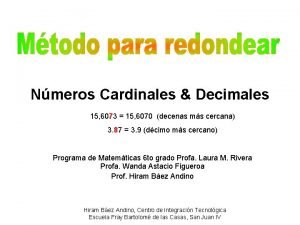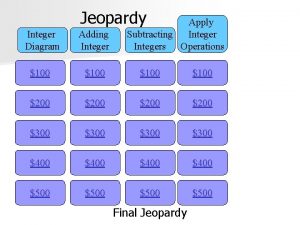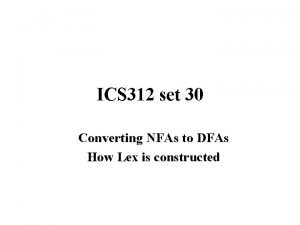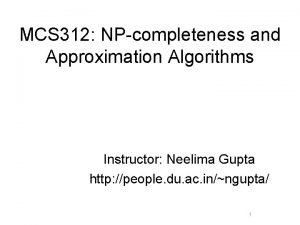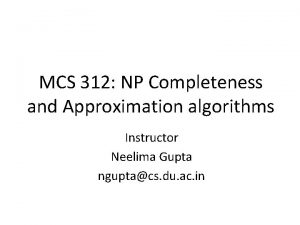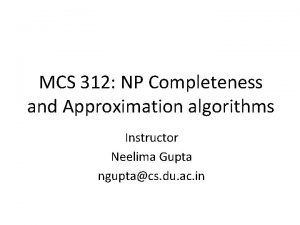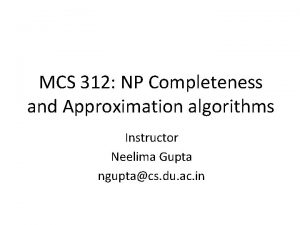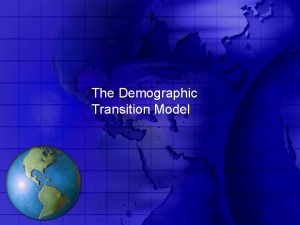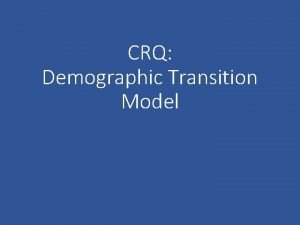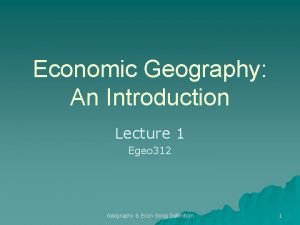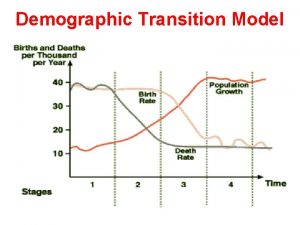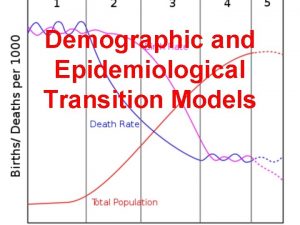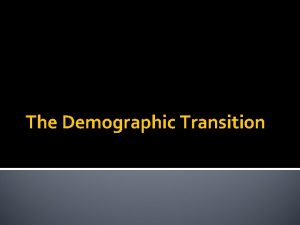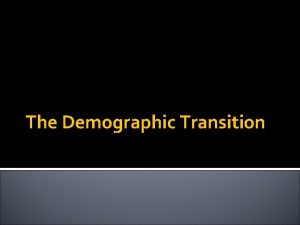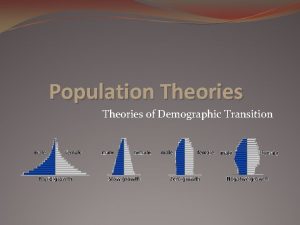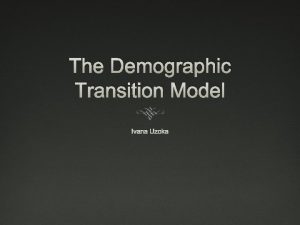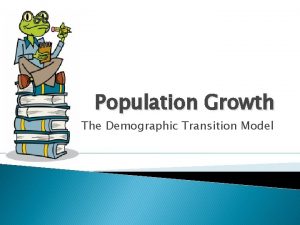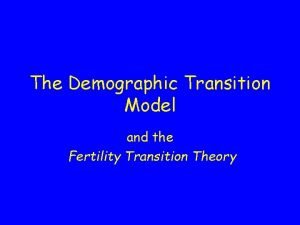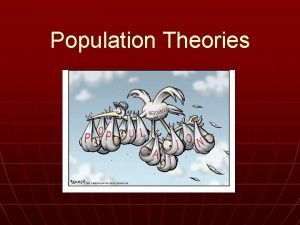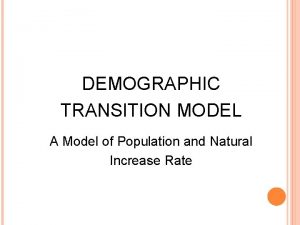DEMOGRAPHIC TRANSITION MODEL Demographic Transition Egeo 312 1



















































- Slides: 51

DEMOGRAPHIC TRANSITION MODEL Demographic Transition Egeo 312 1

Start with Hans Rosling http: //www. youtube. com/watch? v=jbk. SRLYSojo Demographic Transition Egeo 312 2

Today u u Investigate the Demographic Transition Model Investigate Types of Diagrams used to display and map Demographics Demographic Transition Egeo 312 3

1. DEFINING GENERAL TERMS AND CONCEPTS Demographic Transition Egeo 312 4

Basic Terms Crude Birth Rate Crude Death Rate of Natural Increase Infant Mortality Rate Fertility Rate Demographic Transition Egeo 312 5

Crude Birth Rate CBR u Number of live births per year = 3, 180 u Divided by population = 200, 000 u Times 1, 000 CBR = [(3, 180)/200, 000] x 1, 000 CBR = 15. 9 births per 1, 000 people Demographic Transition Egeo 312 6

Crude Death Rate CDR u Number of deaths per year = 1, 860 u Divided by population = 200, 000 u Times 1, 000 CDR = [(1, 860)/200, 000] x 1, 000 CDR = 9. 3 deaths per 1, 000 people Demographic Transition Egeo 312 7

Rate of Natural Increase RNI u CBR = 15. 9 u Minus CDR = 9. 3 u Divided by 10 RNI = (CBR – CDR)/10 = [(15. 9 -9. 3) /10 = 0. 66% growth per year Demographic Transition Egeo 312 8

Infant Mortality Rate IM u number of newborns dying under one year of age = 40 u divided by the number of live births during one year = 5, 300 u Time 1, 000 IM = (40/5, 300) x 1, 000 IM = 7. 6 deaths per 1, 000 births Demographic Transition Egeo 312 9

Fertility Rate u Average Number of child births u Per woman u Since a couple is 2 people, need a little more than 2 births to replace the parents u 2. 1 is considered a stable growth fertility rate in the US of a Developed Country Demographic Transition Egeo 312 10

Types of Diagrams u Demographic Transition Model u Population Pyramid u Trend Diagrams – Temporal (over time) – Spatial (over space u Survivorship Diagram Demographic Transition Egeo 312 11

2. DEMOGRAPHIC TRANSITION MODEL Demographic Transition Egeo 312 12

Birth rate Natural increase Death rate Time Note: Natural increase is produced from the excess of births over deaths. Demographic Transition Egeo 312 13

What is the Demographic Transition Model? u The "Demographic Transition" is a model that describes population change over time. – Our main concern has been growth – Now in Industrial Countries it is decline Demographic Transition Egeo 312 14

What is the Demographic Transition Model? u It is based on an interpretation begun in 1929 by the American demographer Warren Thompson, of the observed changes, or transitions, in birth and death rates in industrialized societies over the past two hundred years or so. Demographic Transition Egeo 312 15

What is the Demographic Transition Model? u The "Demographic Transition" is a model a scientific hypothesis – Until the 1990 s it seemed to work well with Developed Countries – It worked pretty well with Less Developed Countries Demographic Transition Egeo 312 16

What is the Demographic Transition Model? u The "Demographic Transition" is based on the Scientific Method, – so we are continually “experimenting” with it and improving it In this class we will experiment with it in Mexico & Sweden Demographic Transition Egeo 312 17

Impacts and Consequences The next several sets of tables summarizes the measures of impacts of the Transition Four Stages Impacts u 1. Very Low Growth u 2. High Growth u 3. High but Slowing Growth u 4. Low Growth u u Some now see a fifth stage 5. ? ? ? Decline sets in ? ? Factors That Change over the Stages u Family Size u Infant Mortality & Fertility Rates u Family Economics u Status of Kids u Gender Roles u Health Conditions u Transportation Facilities u Child Deaths u Population Size Demographic Transition Egeo 312 18

Demographic Transition Model Stage 1 : Pre industrializa tion: Stable population growth Stage 2: Rapid population growth CBR High Birth rates Family Size -- planned Family Planning -- The general plan is to have many kids Stage 3: Continued and decreasing population growth Stage 4: Stable low population growth Falling Birth rates Low Birth rates Family Planning -- The plan is to have fewer kids Trends stabilize with 2 kid families or less Infant Mortality Rate/ Fertility Rate Many children Still many because few kids because survive, high expect few to fertility rate survive high fertility Lower infant mortality rates -- less pressure to have children, fertility declines Small family size low fertility rate Family Economics Many children are needed to work the land Increased mechanization and industrialization means less need for labor/kids Women are working in great numbers Children are still useful for work Demographic Transition Egeo 312 19

Demographic Transition Model Stage 1 : Pre industrializ ation: Stable population growth CBR Stage 2: Rapid population growth Stage 3: Continued and decreasing population growth Stage 4: Stable low population growth High Birth rates Falling Birth rates Low Birth rates Status of Kids Children are a sign of virility & status and old age insurance Increased desire for material possessions and less desire for large families Kids are an expense & “bling” Gender roles Strong sex roles Emancipation of women Demographic Transition Egeo 312 20

Stage 1 : Pre industrializ ation: Stable population growth Stage 2: Rapid population growth Stage 3: Continued and decreasing population growth Stage 4: Stable low population growth CDR High Death Rates Falling Death rates Rates Low Death rates Low Health Conditi ons Poor Diet & Sanitation, Famine and Disease Improved diet, sanitation & medical care Slight No change improvement Transp ort Faciliti es Limited transport, trade & travel Improved transport to move food and doctors Slight Stable Improvement Child Deaths High child mortality before age 5 A decrease in Child child mortality very low Demographic Transition Egeo 312 After Copper, Models of Demography, Stable 21

Stage 1 : Pre industrializ ation: Stable population growth Stage 3: Stage 2: Continued Rapid and population decreasing growth population growth Rate Natural Increase Very Low Growth High Growth Slowing Growth Population Size Small Population Bigger Stage 4: Stable low population growth Low Growth Biggest After Copper, Models of Demography, http: //www. bized. ac. uk/virtual/dc/copper/theory/th 10. htm Demographic Transition Egeo 312 22

Examples u Sweden – Historic Industrial Country u Mexico – An Industrializing Country Demographic Transition Egeo 312 23

Developed Country Example Demographic Transition Egeo 312 24

Developing Country Example Demographic Transition Egeo 312 25

Combination emphasizing changes over time, Sweden takes longer and Sweden starts from lower CBR and CDR Demographic Transition Egeo 312 26

3. TYPES OF DIAGRAMS Demographic Transition Egeo 312 27

Types of Diagrams u These diagrams help us to understand the mechanism causing the Demographic Transition Model to operate and its impact – Survivorship Diagram – Stabilization Ratio Diagram – Population Pyramids – Temporal Trends – Spatial Trends Demographic Transition Egeo 312 28

Emphasis on longer life expectancy as CDR drops Now 90% live past 55 yrs old Less then 10% reached 25 yrs old Demographic Transition Egeo 312 29

Public Health: One of the many past causes of high child mortality rates Demographic Transition Egeo 312 30

Recent Exponential Growth of World’s Population as countries enter Stage 2 and Stage 3 of the Demographic Transition HIGHLIGHTS IN WORLD POPULATION GROWTH 1 billion in 1804 3 billion in 1960 (33 years later) 5 billion in 1987 (13 years later) 2 billion in 1927 (123 years later) 4 billion in 1974 (14 years later) 6 billion in 1999 (12 years later) Demographic Transition Egeo 312 About 6. 8 bil. currently 31

Total Population of the World by Decade, 1950– 2050 u http: //www. infoplease. com/ipa/A 0762181. html Total world population (mid-year figures) Ten-year growth rate (%) 1950 2, 556, 000, 053 18. 9% 1960 3, 039, 451, 023 22. 0 1970 3, 706, 618, 163 20. 2 1980 4, 453, 831, 714 18. 5 1990 5, 278, 639, 789 15. 2 2000 6, 082, 966, 429 12. 6 20101 6, 848, 932, 929 10. 7 20201 7, 584, 821, 144 8. 7 20301 8, 246, 619, 341 7. 3 20401 8, 850, 045, 889 5. 6 20501 9, 346, 399, 468 — Year (historical and projected) Demographic Transition Egeo 312 32

Stabilization of World’s population is still over a generation away Demographic Transition Egeo 312 33

Guatemala Stage 2 Population Pyramids • Demonstrate where the population is by age cohort • Also can see Demographic Stage Mexico is going into Stage 3 Demographic Transition Egeo 312 34

Stage 4: Sweden Demographic Indicators Birth Rate: 12 per thousand Total fertility rate: 1. 8 births Natural increase: 0. 1% per year 1990 -2000 Age structure: 18% under 15 yrs. age Italy with declining population. Will there be a Stage 5? ? ? Demographic Indicators Birth Rate: 9 per thousand Total fertility rate: 1. 2 births Natural increase: -0. 1% per year 1990 -2000 Age structure: 14% under 15 yrs. age Demographic Transition Egeo 312 35

USA – what Stage would you say each of these are? ? ? Demographic Transition Egeo 312 36

Interactive Pop Pyramid for USA http: //www. nytimes. com/interactive/2011/02/04/business/aging-population. html? ref=business Demographic Transition Egeo 312 37

Japan, an upside down pyramid in the making? Demographic Transition Egeo 312 38

Example of how families adjust to lower infant mortality rates with lower fertility rates. Result is a decline in CBR This is a temporal trend diagram. Demographic Transition Egeo 312 39

Spatial Trend Diagram: Countries with higher IM have higher Fertility Rates. Demographic Transition Egeo 312 40

Comparative Temporal and Spatial Data Diagram What is occuring here? Speculate why. Demographic Transition Egeo 312 41

Comparison of Development and Wealth to Population Growth Rates across Countries Demographic Transition Egeo 312 42

Where is the World’s Population Growing? Declining? Demographic Transition Egeo 312 43

Declining World Mortality Rates Map At the end of the second and the beginning of the third stages of the demographic transition, death rates declined. Where did they first decline and where did they last decline? Created by Ingolf Vogeler on 1 February 1996 http: //www. uwec. edu/geography/Ivogeler/w 111/dempop. htm Demographic Transition Egeo 312 44

ONE LAST CONCEPT Demographic Transition Egeo 312 45

Dependency Ratio u Ratio of non-working population to working age population u Non-Workers are the young and aged retirees – young are usually 15 yrs old and below – retirees are usually 64 yrs old and above Demographic Transition Egeo 312 46

Pakistan’s High Dependency Ratio now and in the future based on lots of kids but few elderly. However note how the young population is expected to stabilize and elderly grow. Demographic Transition Egeo 312 47

Dependency Ratio Woes © Copyright 2006, From The Wilderness Publications, www. fromthewilderness. com. All Rights Reserved. This story may NOT be posted on any Internet web site without express written permission. Contact admin@copvcia. com. May be circulated, distributed or transmitted for nonprofit purposes only. u A rising dependency ratio is also a concern in many countries that are facing aging populations, since it becomes difficult for pension and social security systems to provide to retirees. Demographic Transition Egeo 312 48

Japan showing its high number of dependants to working age population • lots of elderly (nearly black color) • Working age population (purple color) • few kids (dark purple color) Result is high Dependency Ratio Demographic Transition Egeo 312 49

Play time: Hans Rosling http: //www. ted. com/talks/hans_rosling_shows_the_best_stats_you_ve_ever_seen. html Demographic Transition Egeo 312 50

Play time: gapminder. com http: //www. gapminder. org/ Demographic Transition Egeo 312 51
 Carrying capacity ap human geography
Carrying capacity ap human geography Uk demographic transition model
Uk demographic transition model Epidemiological transition model
Epidemiological transition model Demographic transition model ap human geography
Demographic transition model ap human geography Chile demographic transition model
Chile demographic transition model Warren thompson demographer
Warren thompson demographer Haiti dtm stage
Haiti dtm stage Demographic transition model
Demographic transition model Demographic transition model ap human geography definition
Demographic transition model ap human geography definition Demographic transition model population pyramids
Demographic transition model population pyramids Demographic transition model worksheet
Demographic transition model worksheet Demographic transition model song
Demographic transition model song Herbicides definition ap human geography
Herbicides definition ap human geography Afghanistan dtm stage
Afghanistan dtm stage Demographic transition model example
Demographic transition model example Demographic transition model
Demographic transition model Theory of demographic transition
Theory of demographic transition Demographic transition theory
Demographic transition theory Two big breaks in the demographic transition
Two big breaks in the demographic transition Demographic transition
Demographic transition Importance of studying population
Importance of studying population Cse 312
Cse 312 123+132+321+312
123+132+321+312 El-312 nepotism
El-312 nepotism Ics 312
Ics 312 Cse 312
Cse 312 Natural hazards definition ap human geography
Natural hazards definition ap human geography Java 8 312
Java 8 312 Po box 30512 salt lake city
Po box 30512 salt lake city Uw cse 312
Uw cse 312 Sophie nam
Sophie nam Altivar 312 solar
Altivar 312 solar 2-312
2-312 Ssis 312
Ssis 312 21 cfr part 312
21 cfr part 312 312 bus
312 bus Redondear decimales
Redondear decimales Adding and subtracting integers jeopardy
Adding and subtracting integers jeopardy What is the difference between 29 028 and 1 312
What is the difference between 29 028 and 1 312 Instruction
Instruction Ics 312
Ics 312 Ics 312
Ics 312 Simplify fractions
Simplify fractions Jika volume bangun ruang diatas 312 cm
Jika volume bangun ruang diatas 312 cm Mcs 312
Mcs 312 Mcs 312
Mcs 312 Ee 312
Ee 312 Mcs 312
Mcs 312 Mcs 312
Mcs 312 Ee 312
Ee 312 Jika volume bangun ruang diatas 312 cm
Jika volume bangun ruang diatas 312 cm Tesla mission statement
Tesla mission statement
